4211biancagottsasmedia2012
Wednesday, 25 April 2012
Tuesday, 24 April 2012
Monday, 23 April 2012
Logo 2
It came to the conclusion that we preferred the first logo, but creating two gave us the chance to actually decide which logo we thought was better, we had to make a desion whether we wanted our logo to look more professional or more personal, we decided that the first logo was better because the colour scheme followed closely with that of a film noir.
Click here to see the steps to how we created this logo.
Production Meeting
Charley and I have spent the day watching and re watching our OTS and trying to perfect it. since getting to a levle of satisfaction, we've uploaded it to vimeo and embeded it on to our blogs, but since watching it back again we've found there are parts where the sound cuts out completely, we're beginning to find a lot of troubles with our OTS and everytime we think we've nearly finished something else goes wrong.
Actors
Charley and I will be playing Tracey and Lauren, who from the first film are known as Thelma and Louise, we will be interpreting their roles but giving them a new persona, Dillan and Katherine also helped us too.
I will be playing Lauren (Louise)
Dillan will be playing the Detective
Charley will be playing Tracey (Thelma)
Katherine will be playing the house keeper
I will be playing Lauren (Louise)
Logo design
Proof of logo designs click here
We experimented with different designs to open our OTS.
We experimented with different designs to open our OTS.
Production meeting
This morning, Charley and I went to the places where we filmed and took photographs of our locations (which you can see here)
Today we are just adding finishing touches to our OTS getting it uploaded to vimeo and embedding it on our blogs.
Today we are just adding finishing touches to our OTS getting it uploaded to vimeo and embedding it on our blogs.
Thursday, 19 April 2012
Our first attempt at an animatics
First attempt at a story board from SCHS TV on Vimeo.
I have previously posted about the troubles we had creating a story board and how it turned out to be a lot easier to create an animatics because you could place pictures wheereever you wanted and change them around how ever you wanted to.
Animatics final piece
Production meeting
Finally we've been able to find a way of uploading our animatics and first version of our story board to vimeo, by using the schools account we're able to upload larger files and convert them before embedding them to our blogs.
Tried to finish the last part of editing today but couldn't find the file with Dillans voice recording on it, so editing will have to continue tomorrow before it will be complete.
Tried to finish the last part of editing today but couldn't find the file with Dillans voice recording on it, so editing will have to continue tomorrow before it will be complete.
Wednesday, 18 April 2012
Self and Peer assessment sheet
This sheet was helpful to give us feedback and show us which elements people liked and which people didn't think worked as well.
Production meeting
Charley and I decided it was best to try out some foleying today to add more of an effect to our OTS. We struggled with this because we didn't know which sounds in our OTS were clear enough already and which needed to be overlaid. We chose to record some of the sounds in the dark room in school because it was quiet and wasn't bound to have any one in there. Another problem we couldn't seem to work around was finding the right noise for the exact action, or getting the timing right, because we didn't have a big studio where we could watch the clip whilst imitating the action we just had to use what was at our disposal.
Production meeting (backlog)
During the half term Charley and I came in to school for the day to continue our editing but we came across more problems, for example blogger was down in certain areas of the school so we couldn't actually access our blogs to finish large amounts of work, also when we had finished foleying and we tried to upload it to imovie to add it to our OTS the computer wouldn't 'recognize' the camera, so now we're having to work around that and find another way of uploading our foleyed sounds to finalize our piece.
A major problem we had with our OTS was some of the clips would play and then the screen would just turn black, we tried clearing the effects and re adding them numerous times but nothing seemed to work, since being back in school the problem seems to have gone and now all of our footage runs coherently.
A major problem we had with our OTS was some of the clips would play and then the screen would just turn black, we tried clearing the effects and re adding them numerous times but nothing seemed to work, since being back in school the problem seems to have gone and now all of our footage runs coherently.
Production meeting (backlog)
Charley and I tried to upload our animatics to Vimeo -which is a video sharing site; so we could get our projects on to our blogs, but we came across some problems, firstly when we tried to upload the file, it was too large, so then we converted the file to decrease the size and then Vimeo claimed it was too small. We are now still searching for a solution to this problem as our animatics (story board) is an important addition to our planning process for our OTS.
Production meeting
Me and charley came in to school early today to work on our OTS again, today was fairly productive as we managed to get some music involved in our piece, although we have come across a slight problem, we don't quite feel like a certain piece of music, Bob Belden -Before, quite fits in to our piece, we decided to leave it where we originally placed it and we're going to wait for feed back.
Whilst editing the piece today i came across some problems using imovie, some of the transitions wouldn't add to a particular clip, i've now learnt that there is more than one way to add a transition, sometimes using imovie can be quite difficult as i find it's temperamental.
Tuesday, 10 April 2012
Monday, 2 April 2012
Props we used whilst filming
Here are a few pictures of props which we used whilst filming our OTS, everything we used was found in our own homes which is good because it means our production wasn't as costly as we first thought it would be. Charley and I were lucky that I owned two fur coats, because even though our OTS wasn't meant to seem as though it was set in the era which film noir started, we did want to stick to some of the traditional conventions.
Sunglasses used in our get away scene in the woods.
Fur coat 1 (worn by me -Louise/Lauren)
Fur coat 2 (worn by Charley -Thelma/Tracey)
Champagne glasses
Worcester sauce was what we used to create our drinks
The glass which the detective drinks from
Wednesday, 28 March 2012
Story Board
Link to story board on charley's blog
Me and Charley both drew this, but it didn't go so well, this was only a rough draft. We found that this didn't really work for us and was quite time consuming, we also found a more useful way of showing our whole story board by using animatics. Although it's standard practice to use a story board we think this is an old fashioned way, and our research in to film making industry suggets that production teams now days seem to use animatics.
What are the advantages of using animatics?
We'll be able to add sound and give a sense of timing, however we're afraid we might not be able to do it.
Me and Charley both drew this, but it didn't go so well, this was only a rough draft. We found that this didn't really work for us and was quite time consuming, we also found a more useful way of showing our whole story board by using animatics. Although it's standard practice to use a story board we think this is an old fashioned way, and our research in to film making industry suggets that production teams now days seem to use animatics.
What are the advantages of using animatics?
We'll be able to add sound and give a sense of timing, however we're afraid we might not be able to do it.
Production Meeting
Me and Charley came across a lot of problems whilst filming and editing our piece, we found that we filmed too much footage and we had made our OTS in to more of a short film, so we debated different ideas on what we could do to make it shorter and more intruiging.
When we first started to edit our OTS we found that we had about six minutes of footage so to cut this down we took out what we branded 'irrelevant' shots.
When we first started to edit our OTS we found that we had about six minutes of footage so to cut this down we took out what we branded 'irrelevant' shots.
Continuity Task
Untitled from Daniel Mackay on Vimeo.
This is our continuity task, this piece isn't very good but i found that i could reflect on this and use it to my advantage by learning from my mistakes, for example i had never edited before so the editing isn't very great, the cuts between the shots aren't very clear toward the end, and there isn't really much of a story line.
Since filming my OTS i've learnt that a lot of time goes in to the production of the films, all the different angles and shots are trickier than they seem.
Monday, 19 March 2012
Target audience and effect models for our OTS
The target audience for our piece will be aimed at working class women aged 18-40 typically the category which the BBFC would class our OTS as would more than likely be 12A or a 15.
Audience Theory;
Demographics- National Readership Survey
This technique is used to study groups of people, this is a good technique to develop an outlook of the audience for the film. Typical for film noir and neo noir would be a D-B in the National Class Data. The audience for our OTS will probably fit in the C-D category on the BBFC National Class Data.
Mode of Address;
This technique is used to choose how the media product effects and talks to the audience. Typically within a film noir or a neo noir the mode of address is to be aware of women and to not get involved with women who are dangerous AKA the femme fatal. Our mode of address for our OTS will be a mixture of threatening, intimidating and surprising.
Audience Posting;
This technique within the film industry is used to tell the audience what characters the producers want them to support and hate. For our piece we want the audience to empathise with our female characters Thelma and Louise.
Effects Models;
This technique is used to categorise an audience and whether that audience will be suitable for and enjoy the film. Hypodermic syringe is when the audience knows whats happening and just laps up the story and what's going on. Two Step Flow is when someone sees a film and then tells a friend in which that friend tells a friend about the film. JUses and Gratifications is when they accept the film and what it is about and will see it for its typical conventions. Reception Theory is when the audience are unaware of the main concept of a film but take it in due to cultural and religious experience backgrounds. Obstinate Audience Theory is where the audience become so in-tuned with the piece there opinions begin to develop the show.
Audience Decoding;
This is used and has categorised how audiences perceive actions and how it is interpreted within reality and the film.The types of audience are dominant hegemonic which is how society works and thinks in the present, today. We are going for a realistic approach with a horrifying twist, two females that seem innocent but are actually deadly and a threat to society. So in theory we are aiming for dominant hegemonic feel to our OTS.
Audience Theory;
Demographics- National Readership Survey
This technique is used to study groups of people, this is a good technique to develop an outlook of the audience for the film. Typical for film noir and neo noir would be a D-B in the National Class Data. The audience for our OTS will probably fit in the C-D category on the BBFC National Class Data.
Mode of Address;
This technique is used to choose how the media product effects and talks to the audience. Typically within a film noir or a neo noir the mode of address is to be aware of women and to not get involved with women who are dangerous AKA the femme fatal. Our mode of address for our OTS will be a mixture of threatening, intimidating and surprising.
Audience Posting;
This technique within the film industry is used to tell the audience what characters the producers want them to support and hate. For our piece we want the audience to empathise with our female characters Thelma and Louise.
Effects Models;
This technique is used to categorise an audience and whether that audience will be suitable for and enjoy the film. Hypodermic syringe is when the audience knows whats happening and just laps up the story and what's going on. Two Step Flow is when someone sees a film and then tells a friend in which that friend tells a friend about the film. JUses and Gratifications is when they accept the film and what it is about and will see it for its typical conventions. Reception Theory is when the audience are unaware of the main concept of a film but take it in due to cultural and religious experience backgrounds. Obstinate Audience Theory is where the audience become so in-tuned with the piece there opinions begin to develop the show.
Audience Decoding;
This is used and has categorised how audiences perceive actions and how it is interpreted within reality and the film.The types of audience are dominant hegemonic which is how society works and thinks in the present, today. We are going for a realistic approach with a horrifying twist, two females that seem innocent but are actually deadly and a threat to society. So in theory we are aiming for dominant hegemonic feel to our OTS.
Sunday, 18 March 2012
marking criteria for evaluation
Level 4 16–20 marks
Planning and research evidence will be complete and detailed;
There is excellent research into similar products and a potential target audience;
There is excellent organisation of actors, locations, costumes or props;
There is excellent work on shotlists, layouts, drafting, scripting or storyboarding;
There is an excellent level of care in the presentation of the research and planning;
Time management is excellent.
Marking Criteria for the Evaluation
Candidates will evaluate their work digitally. Where candidates have worked in a group, the evaluation
may be presented individually or collectively but the teacher must allocate a mark according to the
contribution/level of understanding demonstrated by the individual candidate. Each candidate should
give a clear indication of their role in any group evaluation.
The questions that must be addressed in the evaluation are:
In what ways does your media product use, develop or challenge forms and conventions of real
media products?
How does your media product represent particular social groups?
What kind of media institution might distribute your media product and why?
Who would be the audience for your media product?
How did you attract/address your audience?
What have you learnt about technologies from the process of constructing this product?
Looking back at your preliminary task, what do you feel you have learnt in the progression from it to
the full product
Level 1 0–7 marks
Minimal skill in the use of digital technology or ICT in the evaluation.
Minimal understanding of issues around audience, institution, technology, representation, forms and
conventions in relation to production.
Minimal ability to refer to the choices made and outcomes.
Minimal understanding of their development from preliminary to full task.
Minimal ability to communicate.
Level 2 8–11 marks
Basic skill in the use of digital technology or ICT in the evaluation.
Basic understanding of issues around audience, institution, technology, representation, forms and
conventions in relation to production.
Basic ability to refer to the choices made and outcomes.
Basic understanding of their development from preliminary to full task.
Basic ability to communicate.
Level 3 12–15 marks
Proficient skill in the use of digital technology or ICT in the evaluation.
Proficient understanding of issues around audience, institution, technology, representation, forms
and conventions in relation to production.
Proficient ability to refer to the choices made and outcomes.
Proficient understanding of their development from preliminary to full task.
Proficient ability to communicate.
Level 4 16–20 marks
Excellent skill in the use of appropriate digital technology or ICT in the evaluation.
Excellent understanding of issues around audience, institution, technology, representation, forms
and conventions in relation to production.
Excellent ability to refer to the choices made and outcomes.
Excellent understanding of their development from preliminary to full task.
Excellent ability to communicate
Planning and research evidence will be complete and detailed;
There is excellent research into similar products and a potential target audience;
There is excellent organisation of actors, locations, costumes or props;
There is excellent work on shotlists, layouts, drafting, scripting or storyboarding;
There is an excellent level of care in the presentation of the research and planning;
Time management is excellent.
Marking Criteria for the Evaluation
Candidates will evaluate their work digitally. Where candidates have worked in a group, the evaluation
may be presented individually or collectively but the teacher must allocate a mark according to the
contribution/level of understanding demonstrated by the individual candidate. Each candidate should
give a clear indication of their role in any group evaluation.
The questions that must be addressed in the evaluation are:
In what ways does your media product use, develop or challenge forms and conventions of real
media products?
How does your media product represent particular social groups?
What kind of media institution might distribute your media product and why?
Who would be the audience for your media product?
How did you attract/address your audience?
What have you learnt about technologies from the process of constructing this product?
Looking back at your preliminary task, what do you feel you have learnt in the progression from it to
the full product
Level 1 0–7 marks
Minimal skill in the use of digital technology or ICT in the evaluation.
Minimal understanding of issues around audience, institution, technology, representation, forms and
conventions in relation to production.
Minimal ability to refer to the choices made and outcomes.
Minimal understanding of their development from preliminary to full task.
Minimal ability to communicate.
Level 2 8–11 marks
Basic skill in the use of digital technology or ICT in the evaluation.
Basic understanding of issues around audience, institution, technology, representation, forms and
conventions in relation to production.
Basic ability to refer to the choices made and outcomes.
Basic understanding of their development from preliminary to full task.
Basic ability to communicate.
Level 3 12–15 marks
Proficient skill in the use of digital technology or ICT in the evaluation.
Proficient understanding of issues around audience, institution, technology, representation, forms
and conventions in relation to production.
Proficient ability to refer to the choices made and outcomes.
Proficient understanding of their development from preliminary to full task.
Proficient ability to communicate.
Level 4 16–20 marks
Excellent skill in the use of appropriate digital technology or ICT in the evaluation.
Excellent understanding of issues around audience, institution, technology, representation, forms
and conventions in relation to production.
Excellent ability to refer to the choices made and outcomes.
Excellent understanding of their development from preliminary to full task.
Excellent ability to communicate
marking criteria for planning
Marking Criteria for the Presentation of the Research and Planning
Research and Planning may be presented in digital format, but can take the form of a folder or
scrapbook at this level. Where candidates have worked as a group, this may be presented collectively,
but teachers are asked to differentiate the contributions of individuals within the group in arriving at a
mark and justifying individual marks on the assessment sheet. Each candidate should give a clear
indication of their role in any group research and planning. As part of the moderation sample, the
moderator will expect to see full evidence of the research and planning informing the construction
process in order to support assessment.
Level 1 0–7 marks
Planning and research evidence will be incomplete;
There is minimal research into similar products and a potential target audience;
There is minimal organisation of actors, locations, costumes or props;
There is minimal work on shotlists, layouts, drafting, scripting or storyboarding;
There is minimal care in the presentation of the research and planning;
Time management may be very poor.
Level 2 8–11 marks
Planning and research evidence may be partially incomplete;
There is basic research into similar products and a potential target audience;
There is basic organisation of actors, locations, costumes or props;
There is basic work on shotlists, layouts, drafting, scripting or storyboarding;
There is a basic level of care in the presentation of the research and planning;
Time management may not be good.
Level 3 12–15 marks
Planning and research evidence will be complete;
There is proficient research into similar products and a potential target audience;
There is proficient organisation of actors, locations, costumes or props;
There is proficient work on shotlists, layouts, drafting, scripting or storyboarding;
There is a good level of care in the presentation of the research and planning;
Time management is good.
Research and Planning may be presented in digital format, but can take the form of a folder or
scrapbook at this level. Where candidates have worked as a group, this may be presented collectively,
but teachers are asked to differentiate the contributions of individuals within the group in arriving at a
mark and justifying individual marks on the assessment sheet. Each candidate should give a clear
indication of their role in any group research and planning. As part of the moderation sample, the
moderator will expect to see full evidence of the research and planning informing the construction
process in order to support assessment.
Level 1 0–7 marks
Planning and research evidence will be incomplete;
There is minimal research into similar products and a potential target audience;
There is minimal organisation of actors, locations, costumes or props;
There is minimal work on shotlists, layouts, drafting, scripting or storyboarding;
There is minimal care in the presentation of the research and planning;
Time management may be very poor.
Level 2 8–11 marks
Planning and research evidence may be partially incomplete;
There is basic research into similar products and a potential target audience;
There is basic organisation of actors, locations, costumes or props;
There is basic work on shotlists, layouts, drafting, scripting or storyboarding;
There is a basic level of care in the presentation of the research and planning;
Time management may not be good.
Level 3 12–15 marks
Planning and research evidence will be complete;
There is proficient research into similar products and a potential target audience;
There is proficient organisation of actors, locations, costumes or props;
There is proficient work on shotlists, layouts, drafting, scripting or storyboarding;
There is a good level of care in the presentation of the research and planning;
Time management is good.
Monday, 5 March 2012
Sound
We've experimented with foleying to create an over lay of sounds, we started off simply by using obvious things to get the correct sound for example using glasses to tap together to make the clinking back ground noise you get in bars and foot steps in an echoey hall to make an over exaggerated noise for the footsteps in the bar. Other things which we used to create sounds were not so obvious for example when the door slams behind the detective in our OTS to create the sound i sat down on a bench in the sports hall of our school, which made a loud banging noise to over emphasise the silence which fills the room of the bar as the detective who seems so out of place enters.
We've decided for our piece we'll want to use multiple tracks, perhaps a get away song, this will differ from our other musical choices because it wont be jazz or very mellow, this will make our piece seem more neo noir.
We've decided for our piece we'll want to use multiple tracks, perhaps a get away song, this will differ from our other musical choices because it wont be jazz or very mellow, this will make our piece seem more neo noir.
Actors
Charley and I will be playing the main characters Thelma and Louise who have changed their names to keep their real identity a secret.
Also various other people from our media class will be helping us out.
Dillan will be our detective
Charley's dad will be driving our get away car
Also various other people from our media class will be helping us out.
Dillan will be our detective
Charley's dad will be driving our get away car
Location
We want to set our OTS in a pub, but we've come across a few problems.
Firstly due to legal reasons we can not smoke in the pub so we wont be able to get the full effect of a film noir, so instead of this we are hopefully going to be using someone's lounge area which has an area which is similar to a bar, hopefully we can work this to our advantage as it does have some benefits filming in a more private area:
Firstly due to legal reasons we can not smoke in the pub so we wont be able to get the full effect of a film noir, so instead of this we are hopefully going to be using someone's lounge area which has an area which is similar to a bar, hopefully we can work this to our advantage as it does have some benefits filming in a more private area:
- we can smoke with the owners permission, without breaking the law
- we can spend more time filming, going over things and improving them
- when using the get away car it will be easier as it's not on a busy road
- we have more freedom of choice when changing and redoing things
Props
Looking through our story board we can now clearly see how many different props we are going to need;
Costume;
Costume;
- High heels
- Fur coats
- 50's styled clothing
- Top hat
- Trench Coat
- Pinny For bartender
- Glasses
- Bottles
- Bottled drink (alcohol included)
- Ash trays
- Bar tables
- Cigarettes/Cigars
Wednesday, 29 February 2012
Camera Angles
Shot Types
MS- (Mid Shot)

Shows some part of the subject in more detail while still giving an impression of the whole subject.
MCU- (Medium Close Up)
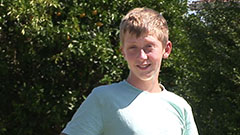
Half way between a MS and a CU
CU- (Close Up)

A certain feature or part of the subject takes up the whole frame.
XCU- (Extreme Close Up)
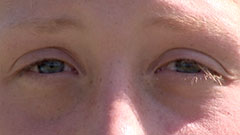
The ECU gets right in and shows extreme detail
2S- (Two Shot)
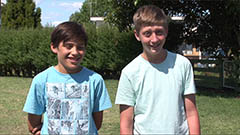
A shot of two people, framed similarly to a mid shot.
OSS- (Over-The-Shoulder Shot)
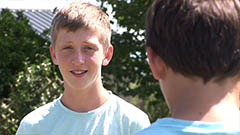
Looking from behind a person at the subject.
VVLS- (Very, Very Long Shot)
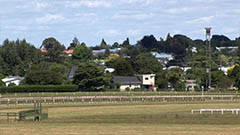
The view is so far from the subject that he isn't even visible. Often used as an establishing shot.
VLS- (Very Long Shot)
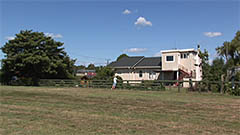
The subject is visible (barely), but the emphasis is still on placing him in his environment.
LS- (Long Shot)

The subject takes up the full frame, or at least as much as comfortably possible.
HSS- (Head And Shoulders Shot)
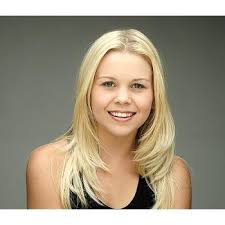
The subject is in the middle of the frame, the frame pictures their head and shoulders

Shows some part of the subject in more detail while still giving an impression of the whole subject.
MCU- (Medium Close Up)

Half way between a MS and a CU
CU- (Close Up)

A certain feature or part of the subject takes up the whole frame.
XCU- (Extreme Close Up)

The ECU gets right in and shows extreme detail
2S- (Two Shot)

A shot of two people, framed similarly to a mid shot.
OSS- (Over-The-Shoulder Shot)

Looking from behind a person at the subject.
VVLS- (Very, Very Long Shot)

The view is so far from the subject that he isn't even visible. Often used as an establishing shot.
VLS- (Very Long Shot)

The subject is visible (barely), but the emphasis is still on placing him in his environment.
LS- (Long Shot)

The subject takes up the full frame, or at least as much as comfortably possible.
HSS- (Head And Shoulders Shot)
The subject is in the middle of the frame, the frame pictures their head and shoulders
Monday, 27 February 2012
Representation of visual conventions
Semiotics & signifiers;
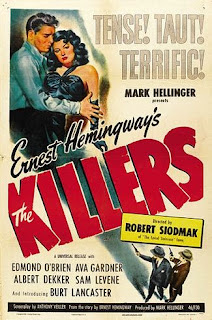 Here, our title is 'The Killers', first off the word 'Killers' is incredibly large which draws our attention to it making it obvious that someone is bound to die in this film and we are more than likely going to see the story unfold from the perspective of the killers. Also the title is in red, red signifies many things e.g blood, violence, passion; this shows us this film is more than likely going to involve all of those things in the plot.
Here, our title is 'The Killers', first off the word 'Killers' is incredibly large which draws our attention to it making it obvious that someone is bound to die in this film and we are more than likely going to see the story unfold from the perspective of the killers. Also the title is in red, red signifies many things e.g blood, violence, passion; this shows us this film is more than likely going to involve all of those things in the plot.
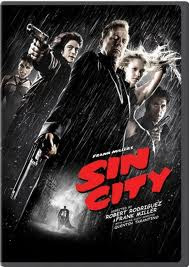 The 'Sin City' dvd case is very similar to 'The Killers' as in the Font is bold and again in read showing us this film will probably be crime orrientated as above.
The 'Sin City' dvd case is very similar to 'The Killers' as in the Font is bold and again in read showing us this film will probably be crime orrientated as above.
femme fatals are typical of film noir's
red lipstick is a great signifier of a glamorous femme fatal
guns and violence are typical of these crime revolved films
fog is used to create dramatic effect, this is a typical convention of film noir's
smoking is a typical convention used in film noir's
The use of Font in the titles;
Fonts used in film noirs as the titles are usually to signify a deeper meaning to the film or are reletive to the story line
for example;
 Here, our title is 'The Killers', first off the word 'Killers' is incredibly large which draws our attention to it making it obvious that someone is bound to die in this film and we are more than likely going to see the story unfold from the perspective of the killers. Also the title is in red, red signifies many things e.g blood, violence, passion; this shows us this film is more than likely going to involve all of those things in the plot.
Here, our title is 'The Killers', first off the word 'Killers' is incredibly large which draws our attention to it making it obvious that someone is bound to die in this film and we are more than likely going to see the story unfold from the perspective of the killers. Also the title is in red, red signifies many things e.g blood, violence, passion; this shows us this film is more than likely going to involve all of those things in the plot. The 'Sin City' dvd case is very similar to 'The Killers' as in the Font is bold and again in read showing us this film will probably be crime orrientated as above.
The 'Sin City' dvd case is very similar to 'The Killers' as in the Font is bold and again in read showing us this film will probably be crime orrientated as above.
Subscribe to:
Posts (Atom)





































